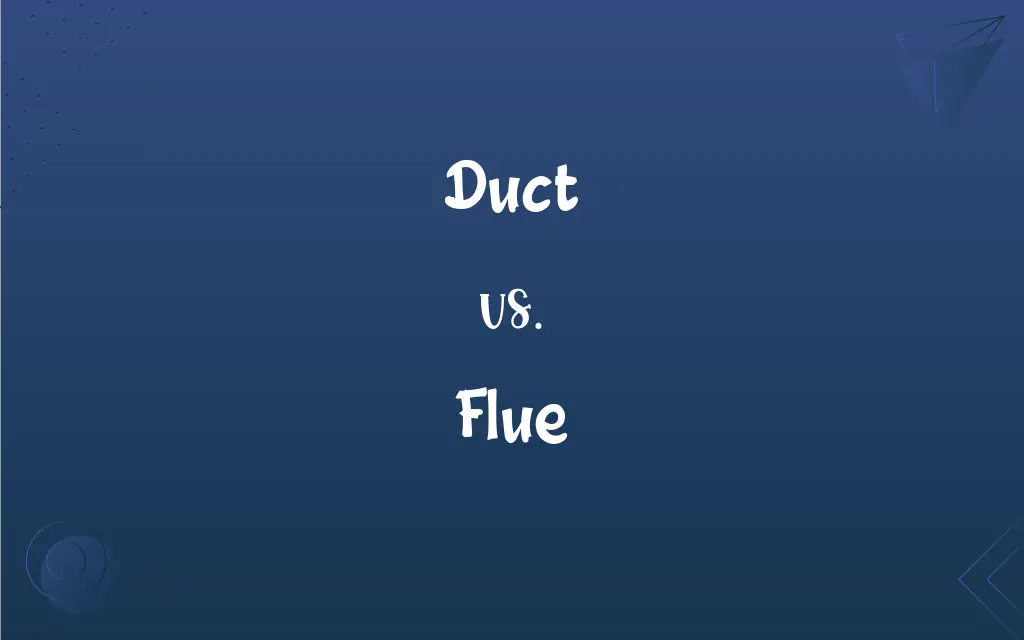Duct vs. Flue: What's the Difference?
By Janet White & Aimie Carlson || Updated on May 23, 2024
A duct is a passage for air or other substances to flow through in heating, ventilation, and air conditioning systems, while a flue is a passageway for smoke and gases to escape from a furnace, fireplace, or chimney.

Key Differences
A duct is a tube or passage used in heating, ventilation, and air conditioning (HVAC) systems to deliver or remove air. Ducts can also be used to transport other substances such as dust or exhaust fumes. A flue, on the other hand, is a pipe or channel that directs smoke and combustion gases from a fireplace, furnace, or boiler to the outside of a building. Flues are essential for safely venting harmful gases such as carbon monoxide out of living spaces.
While both ducts and flues are used to transport substances, ducts are primarily associated with air movement in HVAC systems, and flues are specifically designed for venting smoke and gases from combustion appliances.
Comparison Chart
Primary Function
Transports air or other substances in HVAC systems
Vents smoke and combustion gases from fireplaces, furnaces, or boilers
Material
Metal, fiberglass, plastic
Stainless steel, ceramic, masonry
Usage
Heating, ventilation, air conditioning
Fireplaces, furnaces, boilers
ADVERTISEMENT
Temperature Resistance
Typically lower, designed for air flow
High, designed to withstand hot gases
Safety Role
Maintains indoor air quality
Prevents harmful gases from entering living spaces
Duct and Flue Definitions
Duct
A passage used for conveying air in HVAC systems.
The HVAC technician checked the duct for any leaks.
Flue
Used in fireplaces, furnaces, and boilers.
The old house had a brick flue leading from the fireplace.
Duct
A tube for transporting other substances like dust or fumes.
The factory installed ducts to remove exhaust fumes from the workshop.
ADVERTISEMENT
Flue
Constructed from heat-resistant materials.
Stainless steel flues are common in modern homes.
Duct
Part of a system to control indoor air quality.
Clean ducts are essential for good air quality in homes.
Flue
Prevents buildup of dangerous gases like carbon monoxide.
Regular inspection of the flue helps prevent carbon monoxide poisoning.
Duct
Can be made of various materials including metal and plastic.
The new building used flexible ducts made of durable plastic.
Flue
A pipe or channel for conveying smoke and combustion gases.
The chimney sweep cleaned the flue to ensure proper ventilation.
Duct
An often enclosed passage or channel for conveying a substance, especially a liquid or gas.
Flue
Essential for venting harmful gases safely outside.
A properly functioning flue is crucial for home safety.
Duct
(Anatomy) A tubular bodily canal or passage, especially one for carrying a glandular secretion
A tear duct.
Flue
A pipe, tube, or channel for conveying hot air, gas, steam, or smoke, as from a furnace or fireplace to a chimney.
Duct
A tube or pipe for enclosing electrical cables or wires.
Flue
An organ pipe sounded by means of a current of air striking a lip in the side of the pipe and causing the air within to vibrate. Also called labial.
Duct
To channel through a duct
Duct the moist air away.
Flue
The lipped opening in such a pipe.
Duct
To supply with ducts.
Flue
A fishing net.
Duct
A pipe, tube or canal which carries gas or liquid from one place to another
Heating and air-conditioning ducts
Air duct
Flue
A pipe or duct that carries gaseous combustion products away from the point of combustion (such as a furnace).
Duct
An enclosure or channel for electrical cable runs, telephone cables, or other conductors
Bus duct
Flue
An enclosed passageway in which to direct air or other gaseous current along.
Duct
(anatomy) a vessel for conveying lymph or glandular secretions such as tears or bile
Flue
A woolly or downy substance; down, nap; a piece of this.
Duct
(botany) a tube or elongated cavity (such as a xylem vessel) for conveying water, sap, or air
Flue
In an organ flue pipe, the opening between the lower lip and the languet.
Duct
(physics) a layer (as in the atmosphere or the ocean) which occurs under usually abnormal conditions and in which radio or sound waves are confined to a restricted path
Flue
An inclosed passage way for establishing and directing a current of air, gases, etc.; an air passage
Duct
(obsolete) guidance, direction
Flue
In an organ flue pipe, the opening between the lower lip and the languet.
Duct
To enclose in a duct
Flue
Light down, such as rises from cotton, fur, etc.; very fine lint or hair.
Duct
To channel something (such as a gas) or propagate something (such as radio waves) through a duct or series of ducts
Flue
Flat blade-like projection on the arm of an anchor
Duct
Any tube or canal by which a fluid or other substance is conducted or conveyed.
Flue
Organ pipe whose tone is produced by air passing across the sharp edge of a fissure or lip
Duct
One of the vessels of an animal body by which the products of glandular secretion are conveyed to their destination.
Flue
A conduit to carry off smoke
Duct
A large, elongated cell, either round or prismatic, usually found associated with woody fiber.
Duct
Guidance; direction.
Duct
A bodily passage or tube lined with epithelial cells and conveying a secretion or other substance;
The tear duct was obstructed
The alimentary canal
Poison is released through a channel in the snake's fangs
Duct
A continuous tube formed by a row of elongated cells lacking intervening end walls
Duct
An enclosed conduit for a fluid
Duct
Integral to air distribution and ventilation.
Properly insulated ducts help maintain energy efficiency.
FAQs
What materials are flues made from?
Flues are usually made from heat-resistant materials like stainless steel, ceramic, or masonry.
What is the main function of a duct?
To transport air for heating, cooling, and ventilation purposes.
What is a duct?
A duct is a tube or passage used in HVAC systems to transport air or other substances.
What is a flue?
A flue is a pipe or channel that vents smoke and combustion gases from a fireplace, furnace, or boiler.
What materials are ducts made from?
Ducts can be made from metal, fiberglass, or plastic.
What is the main function of a flue?
To safely vent smoke and combustion gases out of a building.
Do ducts handle high temperatures?
Typically, no; ducts are designed for air flow, not high temperatures.
Where are flues commonly used?
In fireplaces, furnaces, and boilers.
What happens if a flue is blocked?
It can cause dangerous gases to build up inside a home, posing serious health risks.
Where are ducts commonly used?
In heating, ventilation, and air conditioning (HVAC) systems.
What happens if a duct is blocked?
It can lead to poor air quality and inefficient heating or cooling.
Can ducts transport substances other than air?
Yes, they can also transport dust, fumes, and other substances.
Can ducts be insulated?
Yes, insulating ducts can improve energy efficiency and temperature control.
Are flues visible in a building?
They are often hidden but can be visible as part of a chimney or exhaust system.
How often should flues be inspected?
Annually, especially before the heating season begins.
Are flues necessary for all combustion appliances?
Yes, they are essential for venting harmful gases produced by combustion.
Can flues be repaired?
Yes, but repairs should be done by professionals to ensure safety.
Are ducts visible in a building?
They can be hidden within walls, ceilings, and floors, or exposed in some designs.
Do flues handle high temperatures?
Yes, they are designed to withstand hot gases from combustion.
How often should ducts be cleaned?
Regular maintenance is recommended, typically every 3 to 5 years.
About Author
Written by
Janet WhiteJanet White has been an esteemed writer and blogger for Difference Wiki. Holding a Master's degree in Science and Medical Journalism from the prestigious Boston University, she has consistently demonstrated her expertise and passion for her field. When she's not immersed in her work, Janet relishes her time exercising, delving into a good book, and cherishing moments with friends and family.
Co-written by
Aimie CarlsonAimie Carlson, holding a master's degree in English literature, is a fervent English language enthusiast. She lends her writing talents to Difference Wiki, a prominent website that specializes in comparisons, offering readers insightful analyses that both captivate and inform.































































